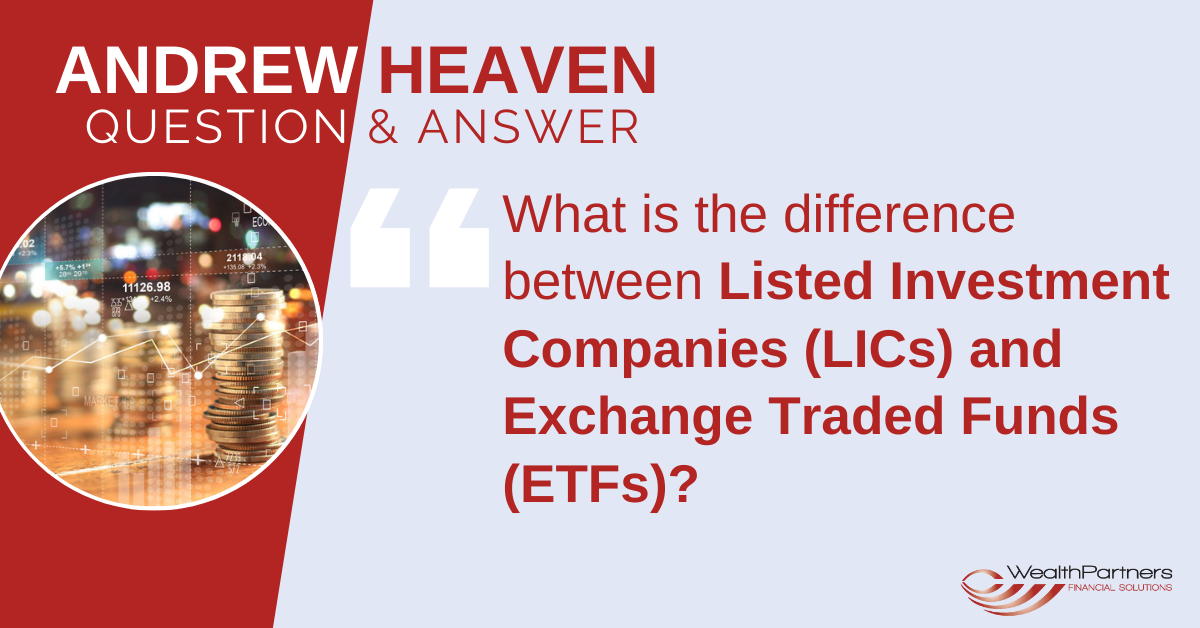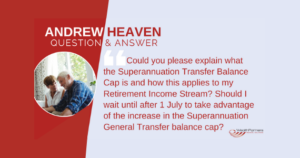Q: I am looking to invest in Managed Funds listed on the ASX for diversification purposes. What is the difference between Listed Investment Companies (LICs) and Exchange Traded Funds (ETFs)?
A: Listed Investment Companies (LICs) are managed investment funds that can be bought and sold on the ASX on a similar basis to an ordinary share. LICs in Australia predominately offer exposure to Australian and International shares but may include exposure to other asset classes such as property and fixed interest.
LICs are closed-ended so there are a finite number of shares available. LIC’s do not regularly issue new shares, so the price of the LIC not only reflects the underlying value of the portfolio of assets but also demand for the expertise of the Investment Manager. Whilst LICs are obligated to report their net tangible assets (NTA), the price of the LIC is determined by the buyer and the seller. Consequently, LIC’s will often trade at a premium or discount to their net tangible assets which can be a major disadvantage depending on the prevailing demand for the LIC.
Exchange Traded Funds (ETFs) can be bought and sold on the ASX on a similar basis as a LIC. The key difference is that ETFs are open-ended and the number of units in the fund is not fixed. Consequently, the price is not determined by supply and demand or the expertise of the manager but rather the net tangible assets of the underlying portfolio of assets.
ETF’s can be either “active” or “passive”. An active ETF portfolio manager ”actively” manages a portfolio of underlying stocks with the aim of outperforming the market. A passive ETF seeks only to replicate an investment index. As they are not trying to outperform the market, passive Index ETFs offer a low-cost exposure to an investment market or asset class. Some of the most popular funds replicate the ASX200, NASDAQ, S&P 500 and the MSCI world index. ETF’s can also provide exposure to currencies, commodities, oil and energy and precious metals such as Gold.
Unlisted Managed Funds still provide the largest range of investment options in the market. Offered either directly by the Fund Manager or via Financial Advisers, most do not charge entry costs. Adviser costs are negotiated between you and the adviser and should be based on advice costs not product costs.
Costs for any investment will vary depending on whether the investment company or fund is actively trading a portfolio or simply replicating an index.
Make sure you understand the underlying investment you are buying. They should be appropriate to your investment time frame and your tolerance for investment risk. Research the quality of the investment manager and seek appropriate professional advice.
Q: Why do some Listed Investment Companies (LICs) trade at a premium or a discount to Net tangible assets?
A: LICs issue a finite number of shares at the time of listing. The share price of the LIC will depend not only on the value of the underlying assets that the fund manager invests in but also the demand for access to the shares in the LIC itself.
Reported net tangible assets (NTA) reflect the value of the underlying assets of a LIC. LICs are obliged to report these valuations to the market on a monthly basis but some report daily or weekly. NTA is often expressed as “pre tax” – gross value without allowing for tax, “post current tax value” -allowing only for provision for tax on profits and “post tax” – provision for tax on profits and realised and unrealised capital gains. Depending on what tax you pay, each of the valuation measures will enable you to determine how you value the LIC based on your circumstances.
From time to time the premium or discount to the NTA of a LIC will vary markedly. This margin is a function of the “on market” supply and demand for the LIC and sentiment.
Investors purchasing at a discount to NTA hope that they will receive an uplift in value if the margin between the NTA and share price closes.
By way of example, the LIC Hearts and Minds (HM1) currently trades at a premium to NTA of approximately 13%. This infers that investors are currently prepared to a pay a premium for having access to the HM1 stock portfolio and their portfolio management skills. However at 30 June 2020, HM1 was trading at a 7.5% discount to NTA.
It can be frustrating for investors for a LIC to trade at a substantial discount to NTA as the trading price does not reflect the underlying value of the assets. For example WAM Alternative assets (WMA) formerly BAF, currently trades at a discount to NTA of 14% but the discount had been greater than 30% two months earlier.
Strategies that LICs can use to close the discount gap between NTA and share price can include on or off market share buy backs. Any buy back at a discount to NTA, benefits remaining shareholders and is typically quantified and disclosed in the annual report of the fund.
Ultimately investors need to decide whether they are prepared to pay a premium to access a LIC or alternatively the opportunity to buy at a discount to the current NTA.


